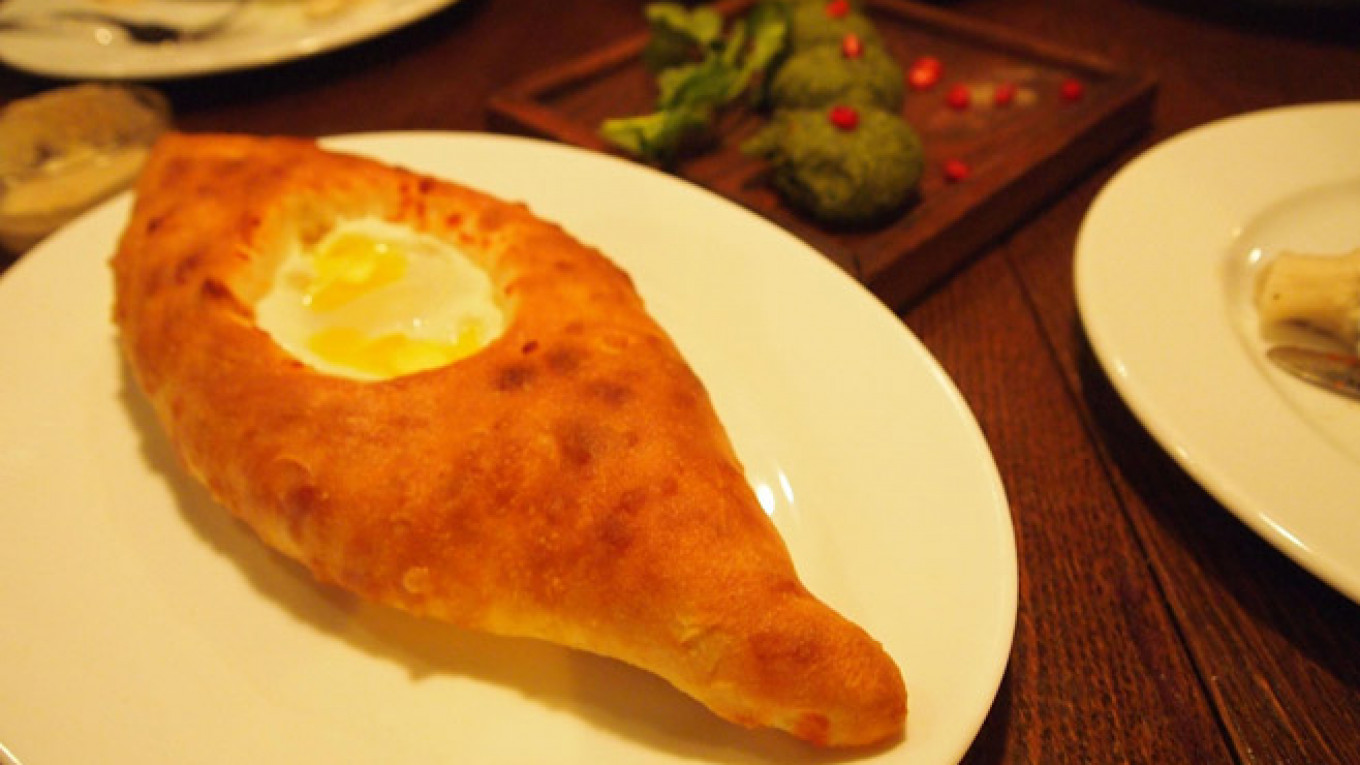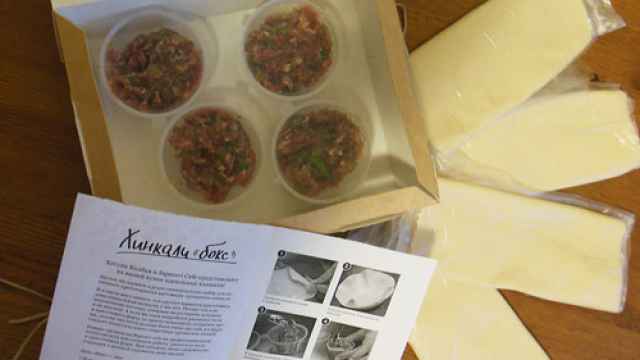On my first trip to Russia, in the late 1990s, a friend took me to a Georgian restaurant. It was located in a building fixed up to look like a rustic cabin, and a menagerie worthy of a taxidermist's office greeted guests as they came in through the front door. The light was dim, the air was smoky and the menu was dominated by khachapuri — the Georgian stuffed cheese bread — and lots of grilled meat. I thought it was awesome.
Explainer: What is Caucasus Cuisine?
Although the Caucasus includes Azerbaijan, Armenia and Russia's North Caucasus republics, the country most often associated with the region's cuisine is Georgia. The country is the home of the beloved cheese-filled bread khachapuri, the cherry-plum based kharcho soup and the fat khinkali dumplings. It also dominates Moscow's Caucasian restaurant scene.
Caucasian cuisine came into Russian gastronomy thanks to the Soviet Union — the idea of the "friendship of peoples" led to the inclusion of many Georgian dishes in Soviet-era cookbooks, and Stalin, an ethnic Georgian, ate and promoted the food of his homeland. The Georgian diaspora in Russia also contributed to the proliferation of Georgian restaurants. The dishes provide a good foil to typically bland Russian food. Georgian meals are full of herbs and spices, although few items are actually spicy.
A typical Caucasian meal will start with plates to share — fresh vegetables, salty regional cheeses, and a wide range of both hot and cold appetizers. Some of the most common are lobio, a kind of bean dip made from either green or red beans; satsivi, a creamy walnut-based sauce usually covering chicken or eggplant; and pkhali — round balls of minced vegetables and spices, served cold.
It can get pretty chilly in the Caucasus Mountains, so the region is known for hearty soups. The most common is kharcho, which includes beef, rice and cherry plum paste. Another soup that has recently gained popularity in Moscow is chakhokhbili, a chicken stew involving tomatoes.
The most typical kind of main dish in a Caucasian restaurant is grilled meat skewers. Every restaurant will offer chicken, lamb and vegetable skewers with many also serving several grilled fishes and veal. Make sure a get sauces to go with your kebabs. You can try tkemali, made from plums, and if you like spicy food, don't miss the thick paste known as adjika.
Don't miss the chance to wash down your meal with some Georgian wine. Georgia considers itself the oldest wine-producing country in the world — in fact, archeologists have discovered evidence of wine cultivation in Georgia more than 8,000 years ago. In terms of red wines, Saperavi is a very drinkable table wine; Kindzmaruli is a semi-sweet red and Mukuzani a dry one. For white wines, try the dry Tsinandali or semi-sweet Tvishi.
Fast-forward 15 years, and Moscow's Georgian food scene has changed almost as much as the diet I now follow as a lactose-intolerant vegetarian. The Khachapuri chain is not new — it's already five years old — but it exemplifies the Caucasian-meets-hipster trend that's taken over Georgian restaurants in the Russian capital. The original Khachapuri, tucked down a side street just off Tverskaya Ulitsa, features wooden floors and metal railings and a quirky selection of chairs. Except for the giant map of Georgia on the wall, you could be in practically any new restaurant in central Moscow. And, like any reasonably priced trendy place, it is incredibly crowded and noisy. But you don't go to Khachapuri for the unique atmosphere — you go for the food.
Khachapuri offers an interpretation of Georgian, but that doesn't mean it isn't good. The menu emphasizes Georgian cuisine's wide range of appetizers, which makes it a great place to go with a crowd. I went for a late lunch one Saturday with a group of newcomers to Moscow, which gave me a chance to try a variety of dishes. The warm bean dip red lobio (290 rubles) is a must for me at any Georgian restaurant, and Khachapuri's was completely fine. I rarely order the cold green lobio, but the one at Khachapuri is absolutely the best in the city. It's only available in the summer, but worth a special trip. I'm a huge fan of eggplant, and was pleased with the eggplant caviar (290 rubles), which comes with a small piece of lavash to dip — for those who aren't into sharing a giant cheese bread. Khachapuri doesn't offer eggplant satsivi, but the sauce on the chicken satsivi (390 rubles) was smooth and creamy. The adjapsandali, a mix of roasted vegetables, also deserves a special mention — both hot (360 rubles) and cold (290 rubles) variants are well seasoned and served in portions big enough to share.
There are main dishes besides roasted meat kebabs (from 360 rubles for chicken to 790 rubles for lamb loin), but I've never been with anyone who ordered them. Khachapuri offers nine varieties of meat kebabs and one vegetable kebab, but no fish. My group praised the tender lamb kebabs, but found the chicken ones a little fatty.
And, of course, there is khachapuri. The restaurant serves nine different kinds of the cheesy bread, many in two sizes (starting at 190 rubles). You can even combine Georgian cuisine stereotypes and get a khachapuri grilled on a skewer.
If you can manage to find room for dessert after your Georgian feast, Khachapuri offers several traditional options ranging from pastries to ice cream to fruit.
Khachapuri. 10 Bolshoy Gnezdnikovsky Lane. 495-764-3118. hacha.ru
Contact the author at artsreporter@imedia.ru
A Message from The Moscow Times:
Dear readers,
We are facing unprecedented challenges. Russia's Prosecutor General's Office has designated The Moscow Times as an "undesirable" organization, criminalizing our work and putting our staff at risk of prosecution. This follows our earlier unjust labeling as a "foreign agent."
These actions are direct attempts to silence independent journalism in Russia. The authorities claim our work "discredits the decisions of the Russian leadership." We see things differently: we strive to provide accurate, unbiased reporting on Russia.
We, the journalists of The Moscow Times, refuse to be silenced. But to continue our work, we need your help.
Your support, no matter how small, makes a world of difference. If you can, please support us monthly starting from just $2. It's quick to set up, and every contribution makes a significant impact.
By supporting The Moscow Times, you're defending open, independent journalism in the face of repression. Thank you for standing with us.
Remind me later.






